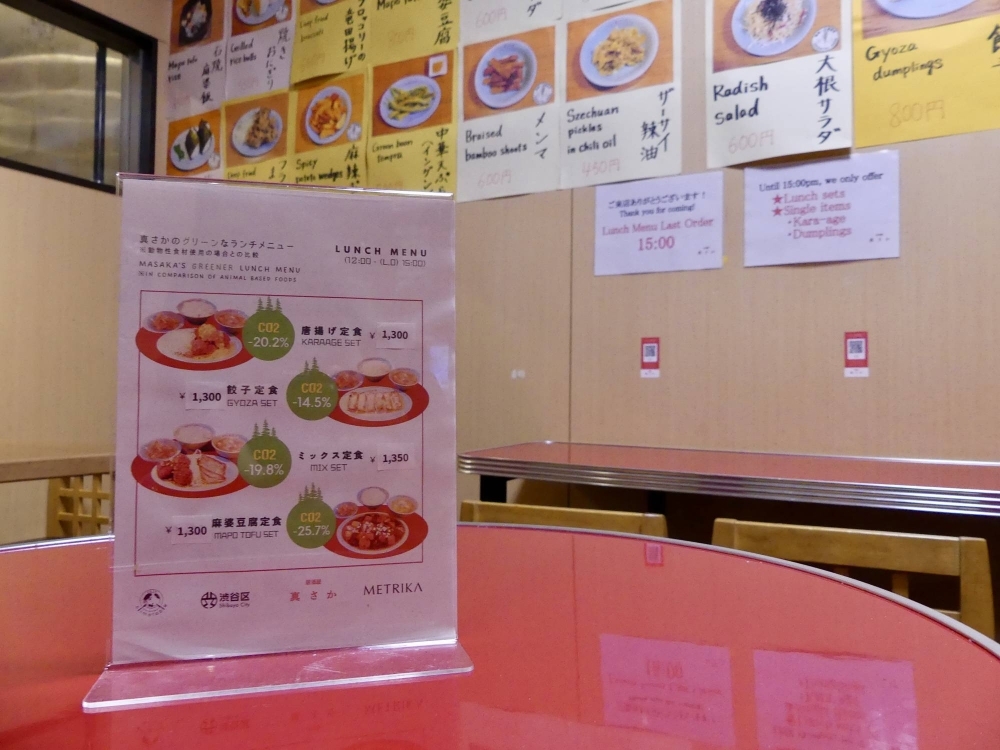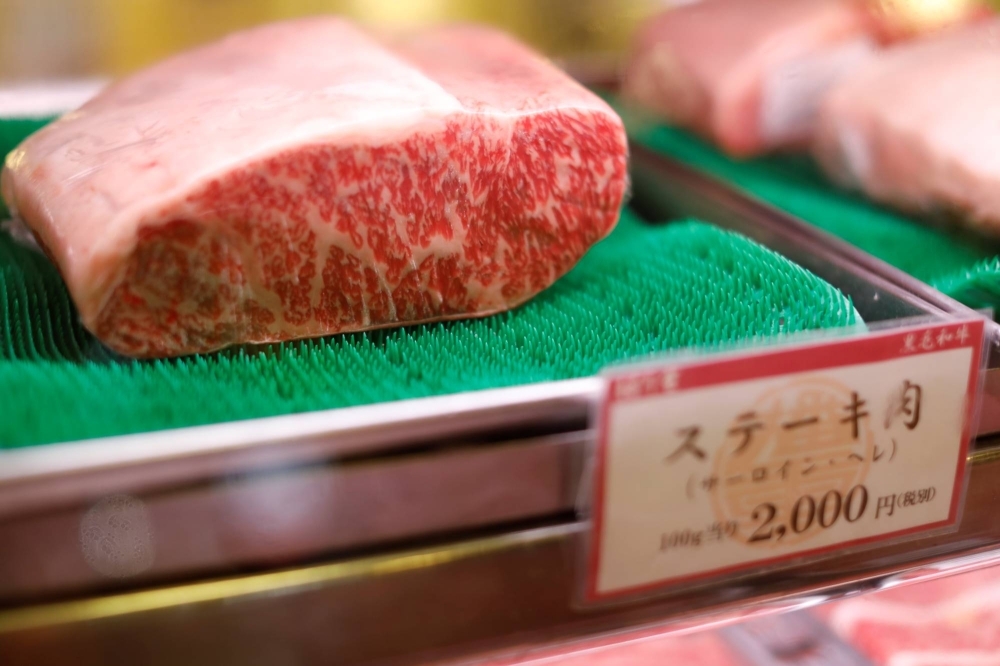Complicated balance between health, climate in Japanese diet
Throughout December, Masaka, a vegan restaurant in Tokyo’s Shibuya Ward, was catering to customers concerned about another issue by having an unusual set of numbers listed on its lunch menu: the rate of carbon dioxide emissions cuts for their dishes compared with meat-based alternatives, The Japan Times reports. Caliber.Az reprints the article.
Masaka showed that its set meal of a vegan version of fried chicken, rice and soup saved 20.2 per cent in emissions compared with a meat-based set of the same portion. Emissions savings for the gyōza dumpling combo were 14.5 per cent, while the mapo tofu set saved 25.7 per cent.
Mayu Suzuki, a spokeswoman for Bird Feather Nob, the company that runs the restaurant, said the disclosure of such information was well received by its customers, with a survey of over 110 visitors showing more than 90 per cent of them supported the initiative.
“I know that people who come to our restaurant are generally more environmentally conscious than average customers, but even then, the fact that this many people replied in the positive makes us feel it was worth the effort,” Suzuki said.

In recent years, food and agriculture have come to be recognized as a major contributor to climate change. Greenhouse gas emissions from food — from its cultivation and transport to distribution, preparation and waste disposal — amount to a third of all human-caused emissions. Beef production is among the biggest contributors.
Recognition of the issue is growing. For example, December’s edition of the COP climate conference devoted a whole day to the food system’s impact on global warming and the need to transform it for the first time in its history. A total of 159 countries signed a declaration on sustainable agriculture, resilient food systems and climate action.
The UN’s Food and Agriculture Organisation (FAO) also unveiled the first step of a road map for achieving the Sustainable Development Goal of “zero hunger” without breaching 1.5 degrees Celsius of warming, with regional and country-level action plans to follow over the next two years.
But a campaign such as one at Masaka — organised jointly with data consultancy Metrika and food-related climate action group Quisine to tie in with COP28 — brings the global issue closer to home by quantifying the environmental impact of our daily meals.
My health or the planet’s?
According to the UN, the largest chunk of food-related greenhouse gases comes from agriculture and land use. This includes methane from cattle’s digestive process, nitrous oxide from fertilizers, carbon dioxide from cutting down forests for the expansion of farmland and other emissions from manure management, rice cultivation, the burning of crop residues and the use of fuel on farms.
But just how emissions-intensive is the Japanese diet?
Rich in traditional plant-based foods and condiments such as tofu, miso and soy sauce, one may expect the Japanese diet to be both healthier and less carbon-emitting than Western counterparts. But the Japanese diet is hard to define, as it has constantly evolved, borrowing from overseas food cultures and tweaking them for the local palate.
Indeed, there is no clear definition of the Japanese diet, and popular perceptions vary on how “Japanese” some modern dishes are, such as curry rice, teriyaki hamburgers and ketchup-based Napolitan spaghetti.

It’s known that a plant-rich and balanced diet that relies less on meat is not only healthy but also friendly to the planet. But in Japan, where meat intake is lower than in many other countries — per capita beef consumption is 7.7 kilograms per year, compared with an OECD average of 14.4 kg — the picture is a little more complex.
Research covering Western diets has shown that the higher the nutritional quality of a diet is, the lower the emissions are, according to Minami Sugimoto, assistant professor of nutritional epidemiology at Toho University in Tokyo. In contrast, her analysis of the diet of 400 adults in Japan has found that diets with higher emissions tend to be healthier.
Diets that are unhealthy can be that way because they are heavy in carbohydrates, and in Japan large amounts of rice, noodles and bread tend to push them in that direction. Meanwhile, healthy diets contain a good balance of vegetables, meat and fish with moderate amounts of carbohydrates.
So how can the Japanese diet be improved to achieve the best balance, where it reduces one’s carbon footprint, fulfills nutritional needs and remains affordable — without forcing drastic changes in people’s eating habits?
Sugimoto’s simulation has shown such a balance can be achieved by increasing the intake of whole grains by four to six times, as people in Japan tend to consume very low amounts of this food source, and drastically cutting the consumption of beef and pork — which have low feed efficiency — by 40 per cent to 50 per cent for beef and around 20 per cent for pork. Such adjustments can reduce the carbon footprint of the Japanese diet by 10 per cent, while increasing the intake of fiber, which it is short of.
“Japan’s leading dietary risk factor for death was its high sodium intake, followed by low intake of dietary fiber,” she says, citing a 2019 Lancet paper that compared the health effects of dietary risks in 195 countries.
Based on Sugimoto’s model, under an optimized diet men would consume 316 grams of vegetables, 107 g of meat, 113 g of fruit and 85 g of legumes and nuts per day. By comparison, the Eat-Lancet model promotes a planet-friendly diet consisting of 300 g of vegetables, 43 g of meat, 200 g of fruit and 125 g of legumes and nuts.
Sugimoto acknowledges that her model, given it results in a meager 10 per cent cut in emissions, would be “the first small step before a big change,” noting that the simulations can be tweaked to produce bigger cuts, although this would require more drastic dietary changes.

Reading the label
Mei Makinouchi, a researcher who specializes in environment and energy issues at the Dai-ichi Life Research Institute, cautions against a drastic reduction of meat for some people, saying it could risk lowering their protein intake below the value recommended in national nutrition guidelines, which is 65 grams per day for men age 18 to 64 and 50 grams per day for women over 18.
That said, it’s important to give people more information to help them choose sustainably produced products, perhaps by actively labeling them, Makinouchi says.
In a survey of 2,370 people by the farm ministry on diets and nutrition in 2023, over 60 per cent said they tend to choose produce and food products that are friendlier to the environment — at least by some measures — such as organic food and food with less packaging. The trend is stronger among women, with nearly 70 per cent saying they did so, compared with just over half of men.
By age, the percentage of people who chose sustainably produced goods was smallest among those in their 20s, with only 27.2 per cent of men and 41.2 per cent of women in this cohort choosing such foods, the survey found.
“But when it comes to the kind of environmental choices they made, many of them cited just choosing domestically or locally produced food,” Makinouchi said.
Some groups in Japan have started certifying products that disclose their carbon footprint, such as the CFP (Carbon Footprint of Products) mark overseen by Sustainable Management Promotion Organization (SuMPO) and the Decarbo Score mark being promoted by Earth Hacks, a joint venture set up last year by major trading house Mitsui & Co. and ad giant Hakuhodo. Meanwhile, groups such as the Vegeproject are trying to increase vegan, vegetarian and plant-based food options in a country where it can be harder to follow those lower-emissions diets.
“To actively promote (low-emissions) choices, I think we need to make better use of certification systems,” Makinouchi said.

At the same time, the environmental impact of rice production — the longtime staple of the Japanese diet — cannot be ignored.
Japan’s methane emissions from agriculture — at 21.9 million tons in carbon dioxide equivalent in 2019 — were less than 10 per cent of the US level the same year, according to farm ministry statistics. Still, agriculture — mostly rice production and livestock farming — accounted for 77 per cent of total methane emissions, much higher than in the US and Europe.
Rice fields are normally flooded with water, but the practice ends up producing more methane — a more potent source of warming than carbon dioxide — as methanogens under the water are likely to proliferate in the environment given there is little oxygen. Methane is then released into the atmosphere through rice plants.
But a farm ministry-affiliated think tank has established a method to reduce methane emissions by 30 per cent by expanding the period when water is withdrawn from the paddies by a week, without having a major impact on rice yield. Farms sticking to the think tank’s manual on how to reduce methane emissions can now participate in the J-Credit program, which allows businesses to trade carbon credits.
Makinouchi says that such efforts should be more widely recognized and become more widespread.
“The fact that such efforts have been certified through the J-Credit program is a welcome step in the right direction,” she said.








